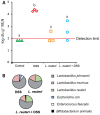Lactobacillus reuteri maintains a functional mucosal barrier during DSS treatment despite mucus layer dysfunction
- PMID: 23029509
- PMCID: PMC3459901
- DOI: 10.1371/journal.pone.0046399
Lactobacillus reuteri maintains a functional mucosal barrier during DSS treatment despite mucus layer dysfunction
Abstract
Treatment with the probiotic bacterium Lactobacillus reuteri has been shown to prevent dextran sodium sulfate (DSS)-induced colitis in rats. This is partly due to reduced P-selectin-dependent leukocyte- and platelet-endothelial cell interactions, however, the mechanism behind this protective effect is still unknown. In the present study a combination of culture dependent and molecular based T-RFLP profiling was used to investigate the influence of L. reuteri on the colonic mucosal barrier of DSS treated rats. It was first demonstrated that the two colonic mucus layers of control animals had different bacterial community composition and that fewer bacteria resided in the firmly adherent layer. During DSS induced colitis, the number of bacteria in the inner firmly adherent mucus layer increased and bacterial composition of the two layers no longer differed. In addition, induction of colitis dramatically altered the microbial composition in both firmly and loosely adherent mucus layers. Despite protecting against colitis, treatment with L. reuteri did not improve the integrity of the mucus layer or prevent distortion of the mucus microbiota caused by DSS. However, L. reuteri decreased the bacterial translocation from the intestine to mesenteric lymph nodes during DSS treatment, which might be an important part of the mechanisms by which L. reuteri ameliorates DSS induced colitis.
Conflict of interest statement
Figures






References
-
- Atuma C, Strugala V, Allen A, Holm L (2001) The adherent gastrointestinal mucus gel layer: thickness and physical state in vivo. Am J Physiol Gastrointest Liver Physiol 280: G922–929. - PubMed
Publication types
MeSH terms
Substances
LinkOut - more resources
Full Text Sources
Other Literature Sources
Molecular Biology Databases
Research Materials

